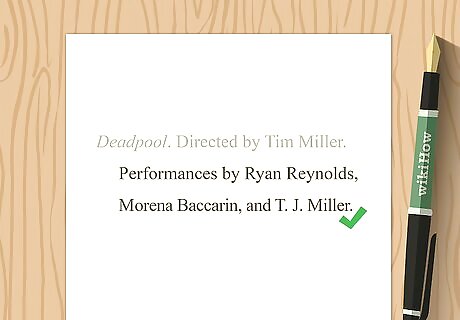
views
MLA

Start with the name of the film in italics. An MLA "Works Cited" entry normally begins with the name of the author. However, for film entries, begin with the name of the film. Use title case, and place a period at the end of the name of the movie. Example: Deadpool.

Provide the name of the director. Type a space after the period following the name of the film. In regular font, type the phrase "Directed by," then list the name of the director in first name-last name format. Place a period after the director's name. Example: Deadpool. Directed by Tim Miller.

Include the names of performers, if relevant. If you refer to specific performances, or characters, in your research paper or presentation, include their names after the phrase "Performances by." Separate names with commas, using the word "and" before the final name. Place a period at the end of the final name. Example: Deadpool. Directed by Tim Miller. Performances by Ryan Reynolds, Morena Baccarin, and T. J. Miller. If the performers aren't relevant to your research paper or presentation, you can leave out this part of the citation.

List the production company and year of release. In place of the publication information you might use for a book, for a film you provide the name of the studio that produced the film, followed by a comma. End your entry with the year the film was released at the box office, followed by a period. Example: Deadpool. Directed by Tim Miller. Performances by Ryan Reynolds, Morena Baccarin, and T. J. Miller. Marvel Entertainment, 2016. Double check to make sure you're using the name of the company that produced the film, not the company that distributed it.

Use the title of the movie in parenthetical in-text citations. MLA typically uses author and page number for in-text citations. Since films don't have page numbers and the movie title is listed first in your "Works Cited" entry, simply use the name of the film. Italicize the name of the film in your parenthetical citation, since it is italicized in the "Works Cited" entry. Example: (Deadpool).
APA

Identify the producer and director as "authors." Start your full reference entry with the last name of the producer, followed by their first initial. Identify them in parentheses as "Producer" of the film, then place a comma after the closing parentheses. Type an ampersand (&) followed by the name of the director, using the same format. Place a period at the end of this part of the entry. Example: Kinberg, S. (Producer) & Miller, T. (Director).

Provide the year the film was released in parentheses. Following the names of the producer and director, list the year the film was released in theaters. Place a period after the closing parentheses mark. Example: Kinberg, S. (Producer) & Miller, T. (Director). (2016).

List the title of the movie and format you used. Type the title of the movie in italics. Use sentence case, capitalizing only the first word and any proper nouns in the title. Type a space, and provide a description of the format you used in square brackets. Place a period after the closing bracket. The format should not be italicized. Example: Kinberg, S. (Producer) & Miller, T. (Director). (2016). Deadpool [Blu-ray].

Close your reference with publication information. For a film, publication information consists of the country where the film originated, followed by a colon. After the colon, type the studio that produced the film, or the production company that distributed the film. Place a period at the end of your citation. Example: Kinberg, S. (Producer) & Miller, T. (Director). (2016). Deadpool [Blu-ray]. United States: Marvel Entertainment.

Use the authors' names and year of release for in-text citations. APA normally follows author-year format for in-text parenthetical citations. In the case of a film, the producer and director are considered the "authors" of the work. Separate the last author's name and the year with a comma. Example: (Kinberg & Miller, 2016).
Chicago

Use the director's name as the "author." Start your Chicago-style bibliography entry with the director's last name. Place a comma after the director's last name, then type their first name. Place a period at the end of the director's first name. Example: Miller, Tim.

Provide the name of the film in italics. After the director's name, type the name of the film. Use title case, capitalizing all nouns, pronouns, verbs, and adverbs in the title, as well as the first word. Place a period at the end of the title. Example: Miller, Tim. Deadpool.

Include publication (or "release") information for the film. Provide the year the film originally came out in theaters, followed by a semi-colon. Identify the city where the studio is headquartered, then a colon, then the studio that produced the film. If you watched the film in any way other than in the theater, provide the year that medium was released. Place a period after the date. If you watched the movie in the theater, place the period after the studio's name. End your citation with the type of medium you used to watch the film. Example: Miller, Tim. Deadpool. 2016; New York City: Marvel Entertainment, 2016. Blu-ray.

Alter the format for in-text footnotes. For a Chicago style footnote, list the director's name in first name-last name order. Use commas instead of periods, and place the "publication information" in parentheses. The only period in a footnote is the one at the very end. Example: Tim Miller, Deadpool (2016; New York City: Marvel Entertainment, 2016), Blu-ray.


















Comments
0 comment